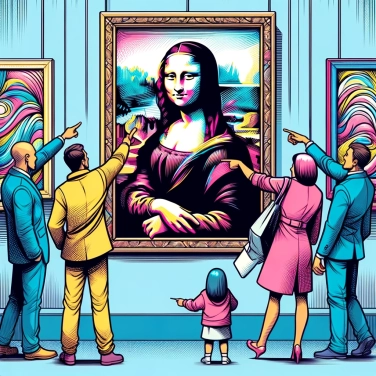The enigmatic smile of the Mona Lisa is due to Leonardo da Vinci's use of a technique called "sfumato", which creates blurred outlines and a soft transition between colors. This gives the illusion that the smile changes depending on the viewer's angle, adding to its mystery.

The Mona Lisa, painted by Leonardo da Vinci between 1503 and 1506, likely takes its name from Lisa del Giocondo, the wife of a wealthy Florentine merchant named Francesco del Giocondo. Although some historians have debated her exact identity, 16th-century records clearly indicate that Leonardo was working on the portrait of this Florentine lady at that time. Florence was experiencing an incredible artistic flourishing, the Italian Renaissance, with famous patrons, rivalries among artists, and bubbling creativity. Leonardo was already recognized as a genius, intriguing and innovative, fueling the curiosity of his contemporaries about the characters he depicted in his works.
Leonardo da Vinci made the smile of the Mona Lisa so unique through the use of the famous sfumato, a technique that involves subtly blurring the contours to create soft transitions. This approach gives her face a vague expression, almost elusive and changing according to the light or the angle of observation. Leonardo also played with fine layers of transparent paint (glazes) that he gradually applied in thin coats, thereby enhancing the effects of depth and realism. The result: her smile appears both natural and mysterious, as if suspended between two emotions, prompting viewers to observe it again and again.
The smile of the Mona Lisa fascinates because it seems to change depending on our perspective or our mood at the moment. (visual ambiguity). Psychologically, it expresses a subtle combination of contradictory emotions, such as joy mixed with melancholy or amusement tinged with secret complicity. Many believe that it implicitly conceals a complex mental state (enigmatic expression) facilitated by Leonardo da Vinci's mastery in painting very light nuances in the features of a face. Symbolically, this discreet smile has been interpreted as a representation of human duality, between the conscious and the unconscious, or as a subtle reflection of feminine mystique (mysterious femininity). Thus, it raises as many questions as it evokes emotions, remaining forever indecipherable (eternal ambiguity).
Recent studies using eye tracking have shown that depending on which area of the face we focus on, the expression of the Mona Lisa seems to change. When looking directly into her eyes, her mouth appears more smiling; but as soon as we look directly at her lips, the smile noticeably fades. Some neuroscientists explain this by peripheral perception: our brain interprets the subtle nuances of expression differently depending on which part of the face we are explicitly looking at. Other researchers highlight a visual trick by Vinci called sfumato, a painting technique with soft and blurred contours, which makes expressions ambiguous and fluid depending on our gaze. Emotional analyses conducted by modern facial recognition software estimate that the dominant emotion of the face is about 83% happy, mixed with a touch of neutrality, or even a hint of irony.
The Mona Lisa and her mysterious smile have become pop icons: ads, parodies, movies, everyone is winking at her. Her intriguing expression continues to fascinate, to the point that everyone has their own interpretation: melancholy, irony, questioning, or gentleness? She is like a mirror where everyone projects their emotions. Leonardo's painting still provokes countless interpretations, proving how much her smile remains a persistent enigma in the collective imagination. Even today, the Mona Lisa still generates conversation, enjoying eternal glory thanks to her forever indecipherable smile.
The Mona Lisa was stolen from the Louvre in 1911, which significantly increased its international fame: until its recovery in 1913, thousands of people came to gaze at the empty space in the museum!
Thanks to his technique of 'sfumato', Leonardo da Vinci manages to create a complex and subtle illusion, varying the expression of the Mona Lisa's smile depending on the viewer's angle or state of mind.
According to certain hypotheses, the features of the Mona Lisa could be a combination of several real and idealized faces, including that of Leonardo himself, thus contributing to the mystery of her unique smile.
Recent analyses have shown that Leonardo da Vinci gradually added fine layers of paint, subtly altering the smile over several years to achieve the current enigmatic effect.
Several factors explain its immense fame; in addition to its exceptional technical quality and enigmatic smile, the spectacular theft of the painting in 1911 from the Louvre Museum also contributed to its international notoriety, causing unprecedented media attention.
This phenomenon results from the subtle artistic techniques employed by Leonardo da Vinci, notably sfumato. This method, involving a delicate and gradual application of colors and shadows, lends Lisa's facial expression a unique ambiguity and visual fluidity.
Modern technologies, such as infrared scanners and 3D digital analysis, now allow researchers to examine the deeper layers of the artwork, revealing previously invisible details and thus providing additional insights into Leonardo's artistic processes and potential intentions.
The painting was created between approximately 1503 and 1517, spanning a long period of nearly 14 years. Leonardo is said to have regularly revised and touched up the canvas, which accounts for the exceptional finesse and visual complexity of the work.
Most historians agree that it is likely the portrait of Lisa Gherardini, the wife of a Florentine merchant named Francesco del Giocondo, which is where the nickname 'La Gioconda' comes from. However, no definitive written evidence confirms this identity with absolute certainty.

No one has answered this quiz yet, be the first!' :-)
Question 1/5